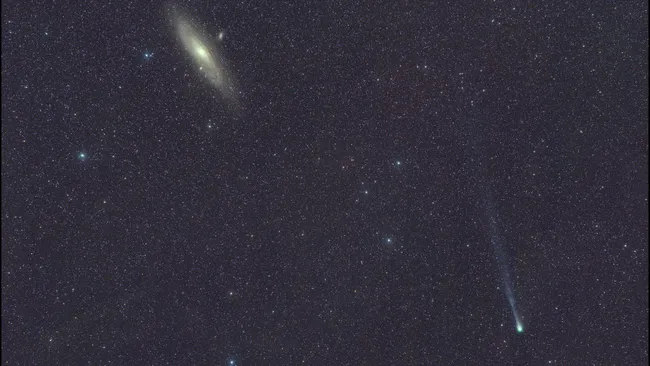12P/Pons–Brooks
29 comments
Hi friends. I came across some interesting news that I want to share with you. Namely:
It is said that Comet Ponce-Brooks can now be seen even with the naked eye. It can be seen just after sunset in the western sky. It is advisable to start looking for it on April 12, when the comet will fly past bright Jupiter. This should make tracking easier. And nine days later, on April 21, Comet Ponce-Brooks will reach its closest point to the Sun and may reach its peak brightness, providing one of the best opportunities to see it.
Now let's talk a little about Comet 12P/Pons-Brooks itself.
The comet was first discovered by astronomer Jean-Louis Pons on July 12, 1812, and was initially described as "a shapeless object with no visible tail." During the next month, the comet became so bright that the object could be seen in the night sky with the naked eye, as well as its bifurcated tail. Further calculations showed that the comet needs about 65-75 years to orbit the Sun. On September 2, 1883, British-born American comet observer William R. Brooks saw this comet again, and it now bears the names of both explorers — Comet Pons-Brooks (12P/Pons-Brooks).

A combination of five 120-second exposures taken by the Virtual Telescope Project in Manciano, Italy, on March 5, showing Comet Ponce-Brooks (lower right) and the Andromeda Galaxy. Source: Gianluca Masi/Virtual Telescope Project
As Space.com points out, last July, due to an unexpected flare, the comet became about 100 times brighter, and the cloud of dust and gas surrounding its nucleus (coma) expanded and began to resemble a horseshoe shape - for this reason, the comet was often called " horned comet" or "devil's comet".
The reasons for such bright flashes are unknown, but some astronomers suggest that Comet Pons-Brooks is a rare member of a group of comets with volcanic activity on the surface.
Привіт друзі. Натрапив на цікаву новину, якою хочу поділитись з Вами. А саме:
Кажуть, що зараз, можна побачити навіть неозброєним оком Комету Понса-Брукса. Це можна побачити відразу після заходу сонця в західній частині неба. Бажано почати шукати її 12 квітня, коли комета пролетить повз яскравий Юпітер. Це ніби повинно полегшити відстеження. А через дев’ять днів, 21 квітня, комета Понсе-Брукса досягне своєї найближчої точки до Сонця і може досягти свого піку яскравості, забезпечуючи одну з найкращих можливостей побачити її.
Тепер давайте трохи про саму комету 12P/Pons-Brooks.
Вперше комету виявив астроном Жан-Луї Понс 12 липня 1812 року і спочатку описав, як «безформний об'єкт без видимого хвоста». Протягом наступного місяця комета стала настільки яскравою, що об'єкт можна було розгледіти на нічному небі неозброєним оком, як і його роздвоєний хвіст. Подальші розрахунки показали, що кометі потрібно близько 65-75 років, щоб облетіти Сонце. 2 вересня 1883 року американський спостерігач за кометами британського походження Вільям Р. Брукс знову побачив цю комету і нині вона має імена обох дослідників — Комета Понса-Брукса (12P/Pons-Brooks).

Комбінація п'яти 120-секундних експозицій, зроблених Virtual Telescope Project у Манчіано, Італія, 5 березня, на яких показана комета Понса-Брукса (внизу праворуч) та галактика Андромеди. Джерело: Gianluca Masi/Virtual Telescope Project
Як зазначає Space.com, у липні минулого року через несподіваний спалах комета стала приблизно в 100 разів яскравішою, а хмара з пилу і газу, що оточує її ядро (кома), розширилася і почала нагадувати формою підкову — через це, комету часто називали «рогатою кометою» чи «кометою диявола».
Причини таких спалахів яскравості невідомі, але деякі астрономи припускають, що Комета Понса-Брукса — це рідкісний представник групи комет з вулканічною активністю на поверхні.
Січень 2024
Лютий 2024
Березень 2024

Comments